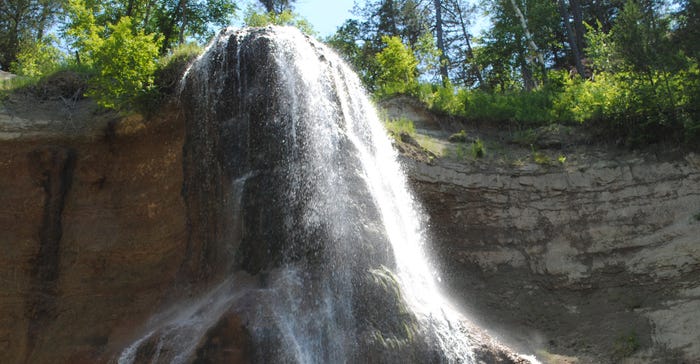
If you have canoed the Niobrara River, you know all about Smith Falls. But most folks from outside Nebraska, or even those who have lived here their entire lives, may not know about the state’s tallest waterfalls — or the fact that Nebraska has waterfalls at all.
As you walk the trail into a shaded spring branch canyon nestled into the south bank of the Niobrara River at Smith Falls State Park just east of Valentine, goosebumps suddenly appear on your arms. The temperature drops noticeably, and you hear the roar of water long before you can see its source. As you round the bend, Smith Falls comes into view — as a place that time has forgotten.
Named for Frederic and Anna Smith, who filed claim on the land in 1896, it stands tall at 70 feet. Until 30 years ago, the only way to access Smith Falls was by canoe. In 1941, Fred Krzyzanowski bought the land and the falls.
He tried to accommodate increased visitation along the Niobrara by building a campground and a picnic area. In the 1960s, Cherry County installed a hand-operated cable car, so the Krzyzanowski children could cross the river to go to school.
The Nebraska Game and Parks Commission opened Smith Falls to the public as a new state park in 1992. In lieu of the cable car, they moved the historic bridge that once carried vehicles across the Verdigre Creek into the village of Verdigre in Knox County out west to Smith Falls — where it now serves as a pedestrian bridge across the Niobrara, allowing walking visitors to reach the falls.
A handicapped-accessible boardwalk was installed to protect the spring branch canyon and stream from heavy public impact. Just as it has for decades, Smith Falls continues to serve as a resting spot for canoers on the river, who stand beneath the cold waters to cool off. But the site is unique for more than just waterfalls.
Biological significance
If there was a real “Gateway to the West,” the hinges would most likely be at Smith Falls. This ecoregion has an unusual mixture, with more than 160 species of plants and animals that live on the very fringe of their distribution.
Three distinct woodland communities have survived here, including the northern boreal forest, distinguished by the presence of paper birch trees; eastern deciduous woodlands; and Ponderosa pine communities that overlap and thrive. Smith Falls serves as the meeting place for mixed grass prairie and Sandhills prairie.
As the last glacier retreated north about 12,000 years ago, the climate in the region changed, getting warmer and drier. Spots that were once occupied by spruce and birch forests became grasslands. The remnants of the colder age survive only in the cool canyons such as the one where a spring-fed stream tumbles over Smith Falls and into the Niobrara River.
Smith Falls is certainly not the only waterfall in Nebraska. There are hundreds. But it is one of the most well-known, thanks in part to the popularity of canoeing and kayaking the river, along with the biological significance the region holds.
Learn more at outdoornebraska.gov/smithfalls.
About the Author(s)
You May Also Like






